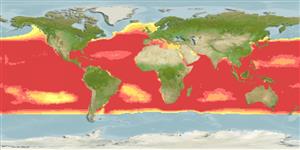Actinopterygii (Straalvinnigen) >
Perciformes (Perch-likes) >
Scombridae (Mackerels, tunas, bonitos) > Scombrinae
Omgeving / Klimaat / Range
Ecologie
; marien; oceanodroom; diepteverspreiding 0 - 260 m (Ref. 9340), usually 0 - ? m (Ref. 55287). Tropical; 15°C - 30°C (Ref. 168), preferred 27°C (Ref. 107945); 63°N - 47°S, 180°W - 180°E
Cosmopolitan in tropical and warm-temperate waters. Not found in the Black Sea. Highly migratory species, Annex I of the 1982 Convention on the Law of the Sea (Ref. 26139).
Length at first maturity / Size / Gewicht / Leeftijd
Maturity: Lm 40.0, range 40 - 45 cm
Max length : 110 cm FL mannelijk/geslacht niet bekend; (Ref. 89423); common length : 80.0 cm FL mannelijk/geslacht niet bekend; (Ref. 168); Maximaal gepubliceerd gewicht: 34.5 kg (Ref. 168); Maximaal vermelde leeftijd: 12 jaren (Ref. 168)
Dorsale stekels (totaal): 14 - 16; Dorsale zachte stralen (totaal): 14-15; Anale stekels 0; Anale zachte stralen: 14 - 15; Wervels: 41. Interpelvic process small and bifid. Body without scales except for the corselet and the lateral line. Swim bladder absent. The back is dark purplish blue, lower sides and belly silvery, with 4 to six very conspicuous longitudinal dark bands which in live specimens may appear as continuous lines of dark blotches.
Found in offshore waters; larvae restricted to waters with surface temperatures of 15°C to 30°C (Ref. 6390). Exhibit a strong tendency to school in surface waters with birds, drifting objects, sharks, whales and may show a characteristic behavior like jumping, feeding, foaming, etc. Feed on fishes, crustaceans, cephalopods and mollusks; cannibalism is common. Spawn throughout the year in the tropics, eggs released in several portions (Ref. 35388). Eggs and larvae are pelagic (Ref. 6769). Preyed upon by large pelagic fishes (Ref. 6885). Also taken by trolling on light tackle using plugs, spoons, feathers, or strip bait (Ref. 9684). Marketed fresh, frozen or canned (Ref. 9340); also dried-salted and smoked (Ref. 9987).
In tropical waters, reproductively active female skipjack tuna spawn almost daily.
Collette, B.B. and C.E. Nauen, 1983. FAO Species Catalogue. Vol. 2. Scombrids of the world. An annotated and illustrated catalogue of tunas, mackerels, bonitos and related species known to date. Rome: FAO. FAO Fish. Synop. 125(2):137 p. (Ref. 168)
Status op de Rode Lijst van het IUCN (Ref. 115185)
CITES (Ref. 94142)
Not Evaluated
Gevaarlijk voor mensen
Reports of ciguatera poisoning (Ref. 4690)
Gebruik door de mens
Visserij: van groot commercieel belang; vis voor de hengelsport: ja
Tools
Speciale rapporten
Download XML
Internet-bronnen
